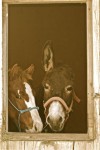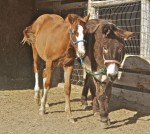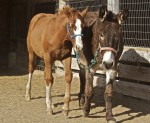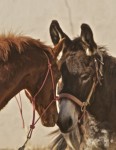 I will be the first to say that I have not been a big fan of the long ears (donkeys and mules) but I am gaining a whole “new found” level of respect for them. I guess I could have be considered “one of those snobby horse people” that would not be caught dead on a mule or with a donkey but I am learning. I would still not trade one of my quarter horses for a long eared companion but I am for sure impressed. My first impressing encounter with a long ear, aka mule, would have been as Cory and I took the horses and Snip (the mule) to the mountains to pack an elk out of what most people would have considered a “steep ass hill.” WOW is really all I had for Snip that day as she stood solid as a rock while getting packed with a whole elk even though her footing was much less then perfect and then crawling out of the canyon with a full load. But…….I am getting a bit away form the topic at hand right now…..Frank the Donkey.
I will be the first to say that I have not been a big fan of the long ears (donkeys and mules) but I am gaining a whole “new found” level of respect for them. I guess I could have be considered “one of those snobby horse people” that would not be caught dead on a mule or with a donkey but I am learning. I would still not trade one of my quarter horses for a long eared companion but I am for sure impressed. My first impressing encounter with a long ear, aka mule, would have been as Cory and I took the horses and Snip (the mule) to the mountains to pack an elk out of what most people would have considered a “steep ass hill.” WOW is really all I had for Snip that day as she stood solid as a rock while getting packed with a whole elk even though her footing was much less then perfect and then crawling out of the canyon with a full load. But…….I am getting a bit away form the topic at hand right now…..Frank the Donkey.
So for the Wikipedia description of Frank…The donkey or ass, Equus africanus asinus,[1][2] is a domesticated member of the Equidae or horse family. The wild ancestor of the donkey is the African Wild Ass, E. africanus. In the western United States, a small donkey is sometimes called a burro (from the Spanish word for the animal).
A male donkey or ass is called a jack, a female a jenny, and an offspring less than one year old a foal (male: colt, female: filly).
While different species of the Equidae family can interbreed, offspring are almost always sterile. Nonetheless, horse/donkey hybrids are popular for their durability and vigor. A mule is the offspring of a jack (male donkey) and a mare (female horse). The much rarer successful mating of a male horse and a female donkey produces a hinny.
Asses were first domesticated around 3000 BC,[3] or 4000 BC, probably in Egypt or Mesopotamia,[4] and have spread around the world. They continue to fill important roles in many places today. While domesticated species are increasing in numbers, the African wild ass and another relative, the Onager, are endangered. As “beasts of burden” and companions, asses and donkeys have worked together with humans for millennia…..so are you bored yet?? I sure am. lol
The last couple of month I have been riding some of my colts at Billingsley Creek Training Center and while over there riding I have been watching as Kay Lynn has been tying one Thoroughbred colt after another to her donkey Frank. I did not pay a ton of attention to what Frank was doing but just thought it was interesting and could possibly come in kinda handy. Soooooo….when it came to weaning time on some of my colts I jumped all over Kay Lynns offer to use Frank to halter break some of my colts. Again I found myself in WOW over the “long ears” fuzzy little guy. It is amazing to watch just how smart he is about breaking the colts lose when they are pulling back and how quickly he gets them respecting the pressure and releasing to it and leading right along. Sure makes my job a ton easier. Ranches such as the great King Ranch and Hillsdale Farms just to name a couple also use a donkey to halter break their colts which is one of the easiest,safest and least stressful ways for the babies to learn how to lead. The other advantage of halter breaking with a donkey I feel, is that your colt has a buddy that takes him right to hay and grain and he seems to worry a whole lot less about mom then if he was by himself or even with another colt.





